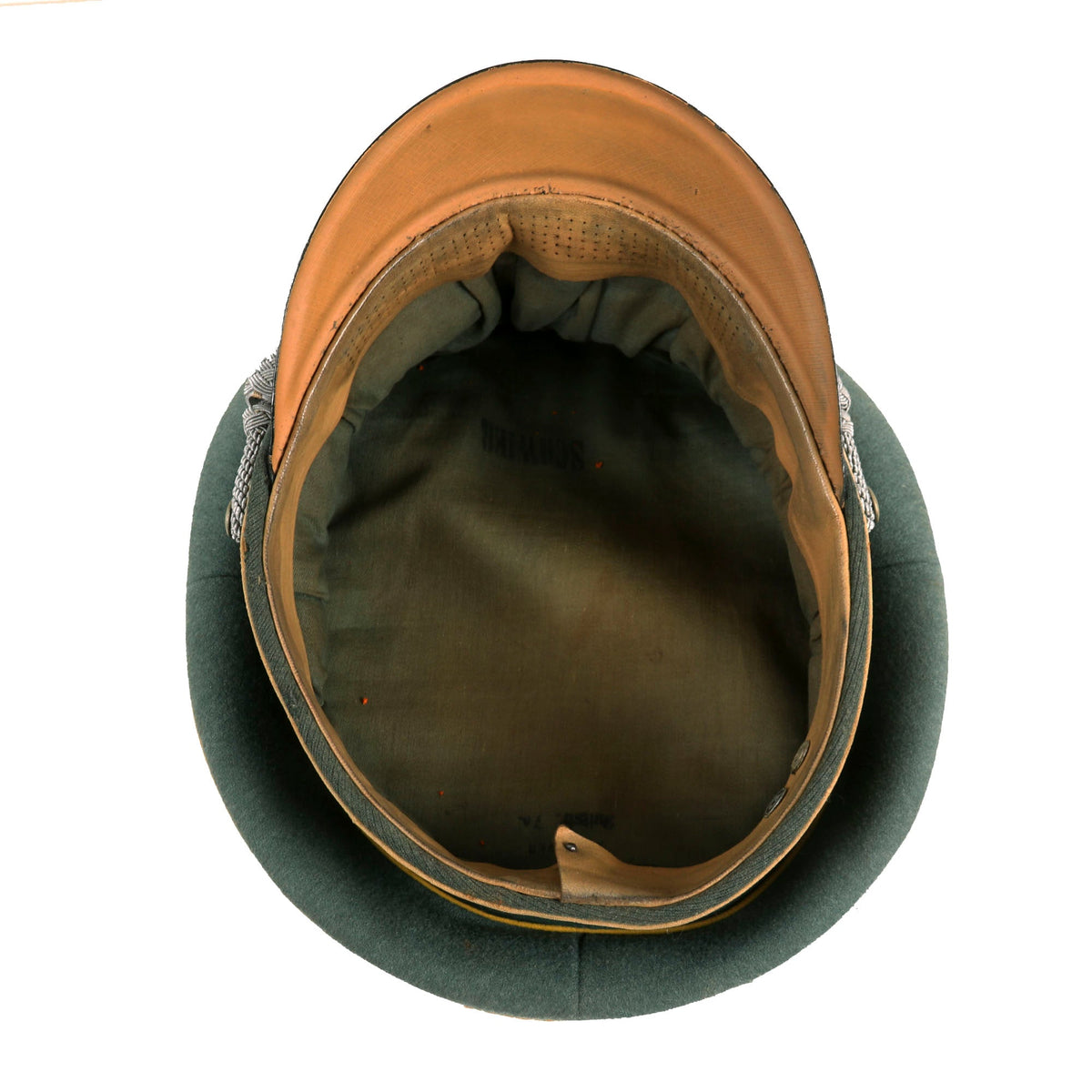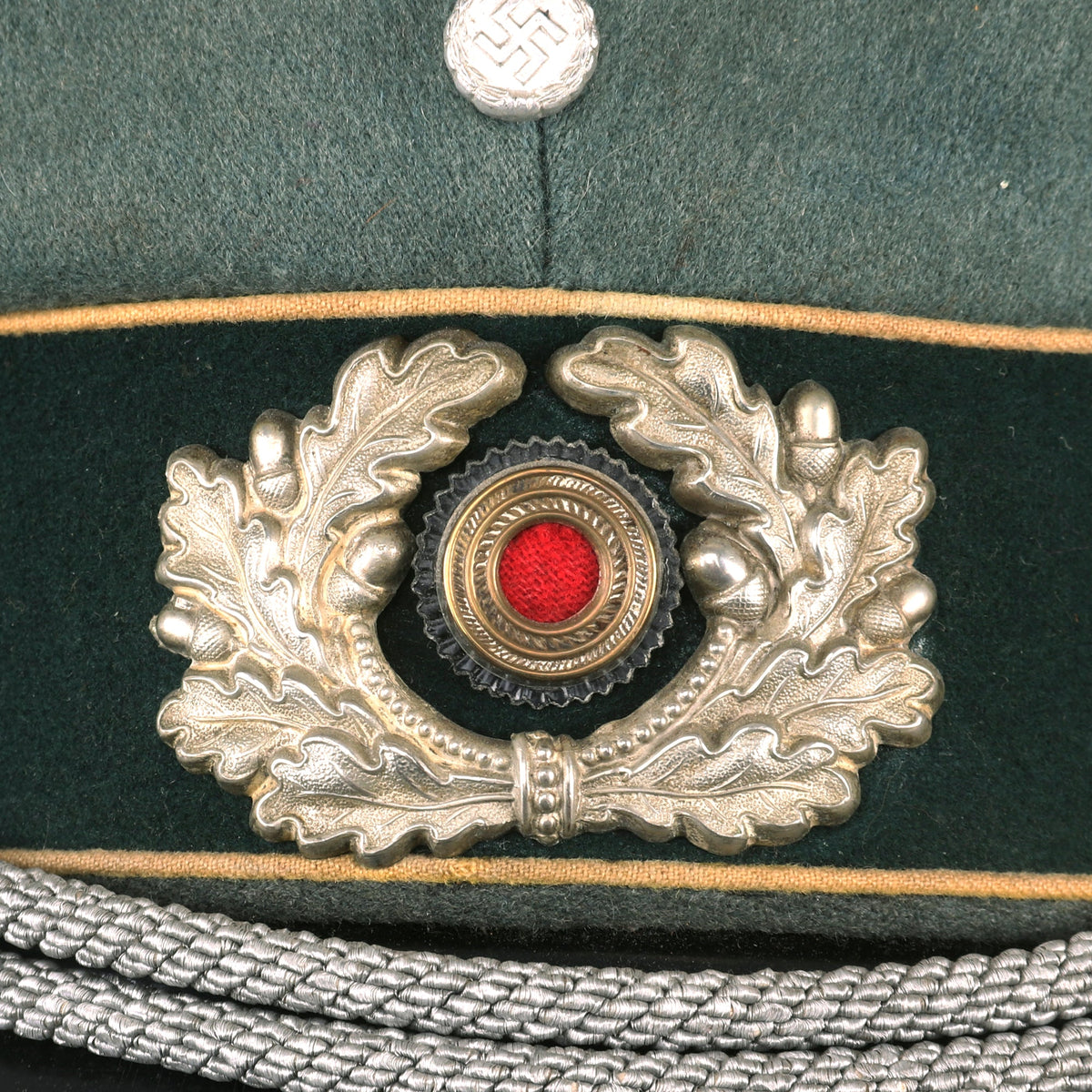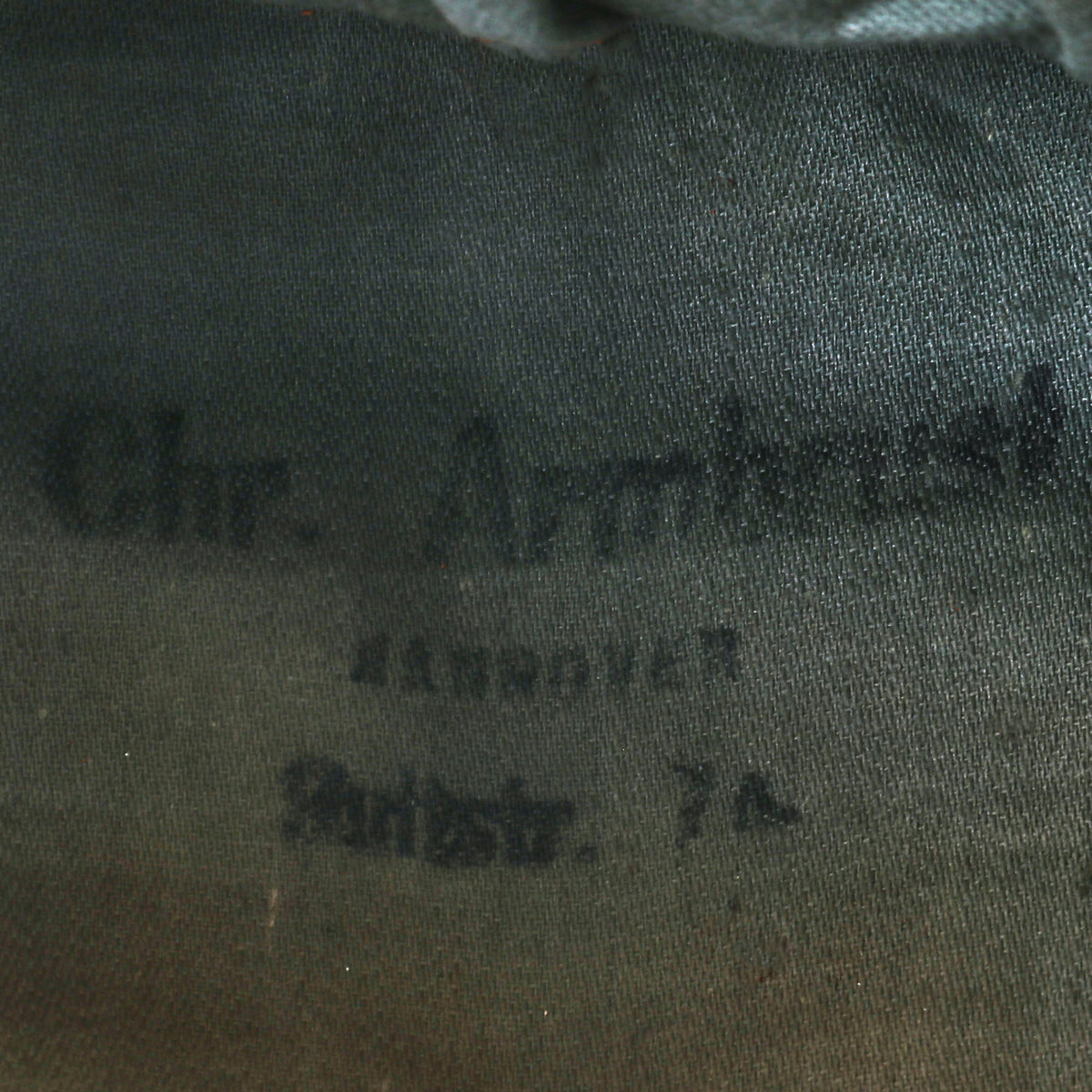Original German WWII Heer Cavalry Officers Schirmmütze Visor Crush Cap by Chr. Armbrust – Faded Piping Original Items
$ 895,00 $ 223,75
Original Item: Only One Available. This cap is a very good service used example of a German WWII Wehrmacht Heer Army Cavalry Officer’s Schirmmütze (visor cap), made by Chr. Armbrust of Hannover, a rare maker that we have not encountered before. The cap has a lovely “Crushed” or “saddle-form” shape that is highly desirable, accomplished by removing the crown support stiffener ring. It features the typical feldgrau (field gray) “doe skin” weave wool construction, very popular with officers, with a flaschengrün (dark bottle-green) “badge cloth” band and a traditional high forward crown. The cap has matching Goldgelb (Golden Yellow) piping along the top edge and flanking either side of the band, the Corps Color (Waffenfarbe) for Cavalry, as well as reconnaissance and armored reconnaissance units with cavalry traditions. It has the correct silver bullion chin strap, indicating that it is for an officer.
Please note that whatever dye was used on the piping on this cap, it was not very resistant to fading from the light, so it now looks almost white in many areas. To see the original color you have to lift up the back of the cap, where it was protected from the light.
It is decorated with a well detailed silvered aluminum eagle insignia on the peak and and an open aluminum oak leaf and acorn wreath surrounding a plated metal tri-color cockade on the band. The insignia have a lovely patina, showing just a bit of age, and the red felt insert in the cockade is still vibrant. The chin strap is attached with the standard silvered buttons on either side of the cap. The vulcanfibre visor has a smooth black leather-look upper, exhibiting light wear along the edge, and is checkered beige on the underside. Unlike most we see, there is just a bit of crazing to the finish, and no checking or flaking. It is still firmly attached to the body of the cap.
The cap is lined with field gray cotton, which over the time has become stained and faded in the center of the crown. It does not look to have been made with a celluloid sweat shield, and looks to be stamped on the inside lining with maker Chr. Armbrust / HANNOVER over the street address. There is also a large SCHWIER stamped near the visor, but we do not know if this is a name or some other marking. The tan leather sweatband is in very good shape, still supple with no tearing, though the rubber padding under the forehead area is crumbling. It has the aluminum initials G O attached to it.
Overall condition is very good, with the main issue being the fading of the piping. The exterior has just a few small moth nips and no major damage or wear. The patinated insignia just give it a great look.
A lovely example of a classic hat worn by German Cavalry Officers in WWII. Very impressive and ready to display!
The German Schirmmütze Visor Cap:
The visor cap (Schirmmütze) was an important part of the headgear worn by German uniformed military, civil, paramilitary and political organizations during the Third Reich. This was the standard cloth headgear worn as a part of the service uniform. Visor caps were worn outdoors as well as indoors, and were often required to be worn by all personnel on duty. Visor caps were made in versions specific to each organization and were often further differentiated through the use of insignia, colored piping, or style of chin cord, to indicate rank, role or branch. The insignia used on these caps ranged from simple stamped metal emblems, to elaborate hand embroidery. Visor caps were issued to enlisted soldiers and NCOs in the military and in some other organizations. Officers had to purchase their own hats, and lower ranks could choose to purchase caps that were of a higher quality than the rather basic, issue examples. The private purchase caps were generally made in very high quality, with fine materials. A wide variety of fabrics were used, from Trikot and doeskin, to heavy wool, or even lightweight white fabric for summer wear. In the military, issue of these caps was generally suspended shortly after the outbreak of the war, but they continued to be worn by some troops until the end of the war.
Fast Shipping with Professional Packaging
Thanks to our longstanding association with UPS FedEx DHL, and other major international carriers, we are able to provide a range of shipping options. Our warehouse staff is expertly trained and will wrap your products according to our exact and precise specifications. Prior to shipping, your goods will be thoroughly examined and securely secured. We ship to thousands clients each day across multiple countries. This shows how we're dedicated to be the largest retailer on the internet. Warehouses and distribution centres can be located throughout Europe as well as the USA.
Note: Orders with more than one item will be assigned a processing date depending on the item.
Before shipping before shipping, we'll conduct a thorough inspection of the items you have ordered. Today, the majority of orders will be delivered within 48 hours. The delivery time will be between 3-7 days.
Returns
The stock is dynamic and we cannot completely manage it because multiple stakeholders are involved, including our factory and warehouse. So the actual stock may alter at any time. It's possible that you may not receive your order once the order has been made.
Our policy is valid for a period of 30 days. If you don't receive the product within 30 days, we are not able to issue a refund or an exchange.
You can only return an item if it is unused and in the same state as the day you received it. You must have the item in its original packaging.
Related products
Uncategorized
Uncategorized
Uncategorized
Uncategorized
Armored Burgonet Helmet & Polearm from Scottish Castle Leith Hall Circa 1700 Original Items
Uncategorized
Uncategorized
Uncategorized
Uncategorized
Uncategorized
Uncategorized
Uncategorized
Uncategorized
Australian WWII Owen MK1 Machine Carbine SMG Custom Fabricated Replica with Sling Original Items
Uncategorized
Uncategorized
Armoured Fighting Vehicles of the World: AFVs of World War One (Hardcover Book) New Made Items
Uncategorized
Uncategorized
Uncategorized
Uncategorized
Uncategorized
Angolan Rebel 1970s era 60mm Inert Display Mortar from Angolan Civil War Original Items
Uncategorized












































































